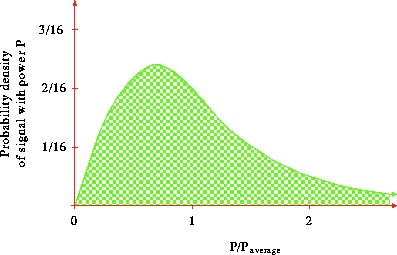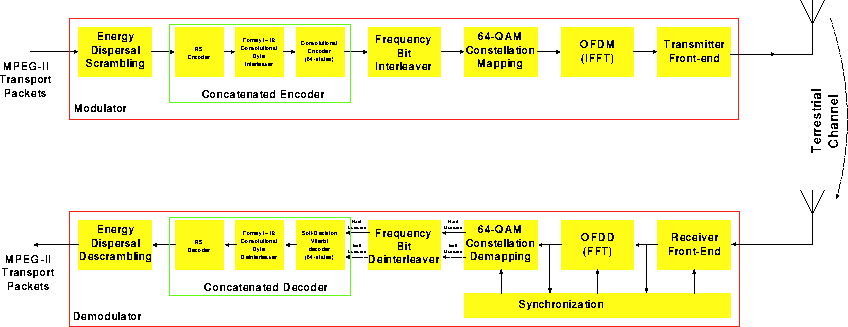
 |
JPL's Wireless Communication Reference WebsiteChapter: Network Concepts and Standards
|
Contributed by Paul G.M. de Bot
Updated by Marc Klaassen, Philips Semiconductors.
Multipath propagation is a predominant factor limiting the service coverage for terrestrial broadcasting. Orthogonal Frequency Division Multiplexing (OFDM) can effectively combat such channel impairments.
However, in Single Frequency Networks (SFN), the echo delay can be as large as 200 microseconds. This means that the guard interval should have a duration of at least this amount. To ensure a sufficiently large transmission efficiency, the (Nyquist) symbol period should be chosen not smaller than 800 microseconds, yielding an efficiency loss of 20% due to the guard interval insertion. If we transmit the symbols with a rectangular pulse shape in the time domain, the Fourier transform of the signal s(t) will be
S(f) = Ts sinc (f - fc) Tswhere fc is the frequency of the carrier. If Ts = 1 milliseconds, the effective bandwidth Fs of the signal is 1 kHz. Since channels of 8 MHz are available for DTTB, we could combine many such narrowband signals in the wideband transmission channel. If we use signals sk(t) with carrier frequencies f(c,k), each exactly 1 kHz apart, the signals are orthogonal. This means that at the receiver side the different signals can be recovered without any mutual cross-talk. This technique is known as Orthogonal Frequency Division Multiplexing (OFDM). OFDM is proposed for DTTB transmission in Europe and Japan. OFDM is also being used in the Digital Audio Broadcasting (DAB) system.
To combine the large number of narrow-band signals into a wide-band OFDM signal, an Inverse Discrete Fourier Transform (IDFT) can be used at the transmitter side, combined with a Discrete Fourier Transform (DFT) at the receiver side. By using a complex IDFT of N = 8192 points, we can multiplex N signals onto an 8 MHz channel. In Europe, this so-called 8K OFDM scheme is currently standardized for DTTB.
Since guard bands in the frequency domain are needed for filtering, a number of carriers at the edges of the 8 MHz channel are left unmodulated (virtual carriers). Only 6817 carriers are modulated giving an effective bandwidth of some 7.61 MHz. out of the 6817 carrier, 6048 are used for broadcast data, the others are used as synchronization pilots.
Hence, in each OFDM time slot we can transmit about 6817 complex-valued symbols. These symbols can be Phase Shift Keying (PSK) or Quadrature Amplitude Modulation (QAM) symbols. The total gross symbol rate over a channel equals about 6817/(Ts + Tg ).
Table: Example of an OFDM scheme for nation-wide SFNs. See ETSI 300 744 for the precise details.
| DFT size | N | 8192 | ||
| sampling frequency | B | 9.1429 | ||
| symbol period | Ts = N/B | 896 microsec | ||
| carrier spacing | Fs= 1/ Ts | 1.17 kHz | ||
| guard interval | Ts/4, .. Ts/32, | 224 .. 28 microsec | ||
| eff. number of subcarrier | NEFF | 6817 | ||
| Eff. Bandwidth | BEFF = NEFFFs | 7.61 | ||
| gross symbol rate | Rg =NEFF/(Ts+Tg) | |||
| net symbol rate | Rn = Rg (93/96) (7/8) |
In previous editions, slightly different parameters have been reported here, based on a proposed standard. See: table.
Another selection of parameters allows the use of channels compatible with the bandwidth of US television channels. By multiplying the symbol duration by 8/7, the bandwidth reduces to 6.65 MHz.
By using OFDM with guard intervals, the problem of ISI in the time domain is solved. Supported guard intervals are 1/4, 1/8, 1/16 and 1/32. However, the frequency selective nature of the channel (due to both multipath and CCI) causes each of the OFDM carriers to be subject to a different signal-to-noise ratio. Error correction coding is needed to recover the information transmitted on the carriers which are subject to low C/N values. In addition, the frequency selectivity can be reduced by using antenna diversity with narrow-band combining. This technique can improve the performance on severely frequency-selective channels by up to 10 dB.

Figure: Amplitude distribution of a typical OFDM signal (large N)
The output of the IDFT at the transmitter side, is a signal of which the amplitude has a very high dynamic range and the peak-to-average power ratio is very large. Therefore, clipping will inevitably occur at the high-power transmitter amplifiers, due to their non-linear behaviour. The percentage of signal which is clipped, depends on the output back-off of the power amplifier. The larger the percentage of signal which is clipped, the more the performance at the receiver side is degraded. Since broadcasters want to operate with cost-effective power amplifiers, a trade-off has to be determined between the nominal amplifier power (and the used output back-off) and the acceptable degradation due to clipping. Another way to improve the performance at the receiver side is to use predistortion techniques on the signal before transmission.

Figure: The DTTB transmission chain